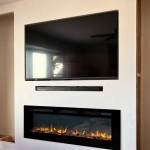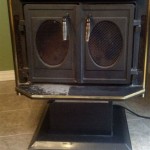Decorative Gas Fireplace Valve Covers: Enhancing Safety and Aesthetics
Gas fireplaces offer a convenient and efficient method for heating homes and creating an inviting ambiance. However, the presence of exposed gas valves and associated piping can detract from the fireplace's overall aesthetic appeal. Furthermore, exposed valves can pose a safety risk, particularly in households with children or pets. Decorative gas fireplace valve covers provide a solution by concealing these functional elements while contributing to the fireplace's visual appeal.
These covers are designed to fit over the existing gas valve and related components, effectively hiding them from view. They are available in a variety of materials, styles, and finishes, allowing homeowners to select a cover that complements their fireplace and overall décor. Beyond aesthetics, valve covers can also offer a degree of protection against accidental tampering or incidental contact with hot surfaces.
Key Point 1: Aesthetic Enhancement and Design Integration
The primary function of a decorative gas fireplace valve cover is to improve the visual appeal of the fireplace. By concealing the utilitarian gas valve and associated piping, the cover creates a more polished and refined appearance. This is especially important in modern homes where homeowners prioritize aesthetics and design consistency throughout their living spaces. The availability of numerous styles ensures that a suitable cover can be found for a range of fireplace designs, from traditional to contemporary.
Materials commonly used in the manufacture of gas fireplace valve covers include cast iron, steel, brass, copper, and even ceramic. Each material offers unique aesthetic qualities and varying degrees of durability. Cast iron and steel are known for their robustness and classic appearance, often featuring intricate designs and durable finishes. Brass and copper offer a more elegant and sophisticated look, complementing fireplaces with ornate details or a warm color palette. Ceramic covers can be customized with a wide range of colors and patterns, allowing for seamless integration with the existing fireplace surround or hearth.
The styles of valve covers vary considerably. Some are designed to mimic traditional fireplace accessories, such as andirons or decorative screens. Others feature sleek, minimalist designs that blend seamlessly with modern fireplaces. Some covers incorporate decorative elements, such as floral patterns, geometric shapes, or even miniature sculptures, adding a touch of artistic flair to the fireplace. The selection of a specific style depends largely on the homeowner's personal preferences and the overall design aesthetic of the room.
The finish of the valve cover is another crucial factor in achieving a cohesive design. Common finishes include matte black, antique brass, polished chrome, and painted colors. Matte black is a versatile option that complements a wide range of fireplace styles, while antique brass adds a touch of vintage charm. Polished chrome offers a sleek and modern look, particularly suitable for contemporary fireplaces. Painted finishes allow for a greater degree of customization, enabling homeowners to match the valve cover to the colors of the fireplace surround or the surrounding walls.
The size and shape of the valve cover should also be carefully considered. The cover should be large enough to completely conceal the gas valve and associated piping without appearing disproportionately large or bulky. The shape of the cover should complement the overall design of the fireplace, whether it is rectangular, arched, or curved. Some valve covers are designed to be adjustable, allowing for a customized fit based on the specific dimensions of the gas valve and surrounding components.
Beyond simply concealing the gas valve, some decorative valve covers incorporate additional features that enhance the fireplace's aesthetic appeal. For example, some covers include built-in shelves or ledges that can be used to display decorative objects, such as candles, figurines, or plants. Others feature integrated lighting, creating a warm and inviting glow that accentuates the fireplace's architectural details. These features can transform the valve cover from a purely functional accessory into a focal point of the fireplace design.
Key Point 2: Safety Considerations and Protective Functionality
While aesthetics are a primary consideration, decorative gas fireplace valve covers also offer a degree of safety and protection. The cover acts as a barrier, preventing accidental contact with the gas valve and associated piping. This is particularly important in households with young children or pets who may be tempted to touch or tamper with the exposed components.
Gas valves can become hot during operation, especially when the fireplace is used for extended periods. A valve cover can help to reduce the risk of burns by providing a layer of insulation between the hot valve and anyone who might accidentally touch it. Some valve covers are specifically designed with heat-resistant materials and ventilation to further mitigate the risk of burns.
The cover also helps to protect the gas valve and associated piping from damage. This is particularly important in areas with high foot traffic or where objects might accidentally be knocked against the fireplace. By shielding the valve from impact, the cover can help to prevent leaks or other malfunctions that could compromise the safety of the fireplace.
Furthermore, in some cases, valve covers may offer a degree of protection against tampering. While they are not designed to be impenetrable, they can deter casual attempts to adjust or manipulate the gas valve. This can be particularly important in rental properties or other situations where access to the gas valve may be less controlled.
It is critical to select a valve cover that is specifically designed for use with gas fireplaces and that meets all applicable safety standards. The cover should be made from non-combustible materials and should be properly ventilated to prevent overheating. It is also important to ensure that the cover does not obstruct the flow of air to the fireplace or interfere with the operation of any safety devices, such as the pilot light or flame sensor.
Installation of the valve cover should be performed by a qualified professional to ensure that it is properly secured and that it does not pose any safety hazards. The installer should also verify that the cover does not interfere with the operation of the gas valve or any other components of the fireplace.
Key Point 3: Installation and Maintenance
The installation process for a decorative gas fireplace valve cover varies depending on the specific design and attachment method. However, it typically involves securing the cover to the existing fireplace structure or around the gas valve itself. It is crucial to follow the manufacturer's instructions carefully to ensure proper installation and avoid any potential safety hazards.
In many cases, the valve cover will attach to the fireplace hearth or surround using screws or other fasteners. It is important to use appropriate hardware that is compatible with the materials of both the valve cover and the fireplace structure. The cover should be securely fastened to prevent it from shifting or falling off, especially in households with children or pets.
Some valve covers are designed to simply sit over the gas valve without requiring any permanent attachment. These covers typically feature a weighted base or non-slip feet to prevent them from moving around. This type of cover is easier to install and remove, making it a convenient option for homeowners who want to be able to access the gas valve easily.
Regardless of the installation method, it is important to ensure that the valve cover does not obstruct the vents or air inlets of the fireplace. Proper ventilation is essential for the safe and efficient operation of the fireplace. Obstructing the vents can lead to overheating, carbon monoxide buildup, or other safety hazards.
Maintenance of a decorative gas fireplace valve cover is typically minimal. The cover should be cleaned regularly to remove dust and debris. The frequency of cleaning will depend on the environment and the amount of use the fireplace receives. A soft cloth or brush can be used to gently wipe down the surface of the cover. Avoid using harsh chemicals or abrasive cleaners, as these can damage the finish.
Periodically inspect the valve cover for any signs of damage, such as cracks, dents, or loose fasteners. If any damage is found, the cover should be repaired or replaced immediately. A damaged valve cover can pose a safety hazard and may not provide adequate protection for the gas valve.
It is also important to ensure that the valve cover does not interfere with the operation of the gas valve. Regularly check to see if the valve turns freely and that there are no obstructions. If the valve cover is preventing the valve from operating properly, it may need to be adjusted or removed.
Ultimately, selecting and installing a decorative gas fireplace valve cover is a process that incorporates elements of design, safety, and practical consideration. By carefully assessing individual needs and preferences, homeowners can enhance the beauty and safety of their gas fireplaces.

Broe Patina Gas Fireplace Fire Pit Valve Cover Kit

What Is A Gas Fireplace Escutcheon

Blue Flame Gas Valve Cover For 1 2 In And 3 4 Valves Bf 36518 The Home Depot

How To Install A Decorative Key Valve And Trim Ring

Blue Flame Decor Gas Valve With Bushing In Antique Copper Uf Aco 08 The Home Depot

Gas Valve Replacement Key

Universal Decor And Key Kit For Gas Valves Valve Not Included Antique Brass Finish

Blue Flame 1 5 In Universal Decor Uf Ch 01 The Home Depot

Affordable Universal Gas Valve Keys And Floor Plates For Fireplaces

How To Install A Decorative Key Valve And Trim Ring








